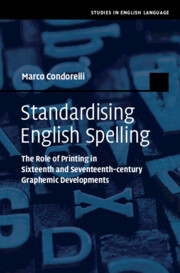 Standardising English Spelling
Standardising English Spelling Book contents
- Standardising English Spelling
- Studies in English Language
- Standardising English Spelling
- Copyright page
- Contents
- Figures
- Tables
- Acknowledgements
- Abbreviations
- Chapter 1 Introduction
- Part I Context
- Part II Empirical Method
- Part III Case Studies
- Chapter 7 The Standardisation of Positional Spellings
- Chapter 8 The Standardisation of i and y
- Chapter 9 The Standardisation of Etymological Spelling
- Chapter 10 The Standardisation of Vowel Diacritic Spelling
- Chapter 11 Conclusion
- Bibliography
- Index
Chapter 9 - The Standardisation of Etymological Spelling
from Part III - Case Studies
Published online by Cambridge University Press: 31 March 2022
- Standardising English Spelling
- Studies in English Language
- Standardising English Spelling
- Copyright page
- Contents
- Figures
- Tables
- Acknowledgements
- Abbreviations
- Chapter 1 Introduction
- Part I Context
- Part II Empirical Method
- Part III Case Studies
- Chapter 7 The Standardisation of Positional Spellings
- Chapter 8 The Standardisation of i and y
- Chapter 9 The Standardisation of Etymological Spelling
- Chapter 10 The Standardisation of Vowel Diacritic Spelling
- Chapter 11 Conclusion
- Bibliography
- Index
Summary
Chapter 9 focuses on the analysis of etymological spelling, and especially the insertion of <b>, <c>, <d>, <l> and <p> in Early Modern English word forms, the development of alternant <aun> and <ph>, and the rationalisation of <er>/<ar>. My results indicate that etymologised spellings appeared increasingly more markedly between the early and the mid-sixteenth century, while only a percentage of the forms which developed during these decades continued until the seventeenth century. My investigation shows that the etymologising developments in epenthetic graphemes, <aun>, <ph> and <er>/<ar> spread out not gradually, from high-frequency words to lower-frequency ones, but rather at largely comparable frequencies across most of the English vocabulary, albeit somewhat erratically and haphazardly across legitimate and illegitimate etymologies. The discussion reflects upon the development of the etymological spellings, focusing especially on the potential interaction between authors and printers as agents responsible for the modern standardisation during the process of in-house proofreading. Overall, I suggest, changes occurring in the English printing industry were primarily responsible for the different etymologising trends between the sixteenth and the seventeenth centuries.
Keywords
- Type
- Chapter
- Information
- Standardising English SpellingThe Role of Printing in Sixteenth and Seventeenth-century Graphemic Developments, pp. 171 - 191Publisher: Cambridge University PressPrint publication year: 2022


